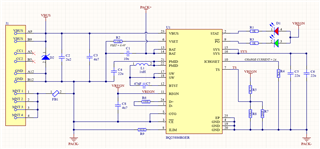Hi,

In this design, while testing, The PG LED is turned ON. However, the STAT LED is blinking at 1 HZ. While looking in the datasheet, multiple reasons are listed for this behaviour.

The input Voltage is 5.12 V. Battery Voltage is 7.23 V.
Here I am not using NTC and the voltage across the TS pin is around 4.1 V. Is not using an NTC an issue? What combination should I use for the voltage divider ignoring the NTC? or is there any other issue?
Note: R5 = 5.23 K, R8 is 30.1K. R7 is not populated.




